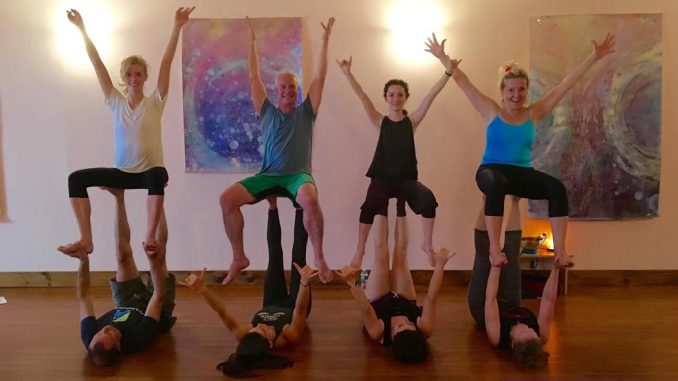
Flying upside down and spinning people in the air with the strength of your legs is the norm at Vitality Yoga Flow, located in the Tops shopping plaza.
Vitality’s Sunday night AcroYoga class is the first to be taught weekly in New Paltz. This modern practice “blends the spiritual wisdom of yoga, the loving kindness of Thai massage, and the dynamic power of acrobatics,” according to the yoga studio’s web page.
Lana Heintjes began instructing the AcroYoga class at the beginning of June. She discovered AcroYoga six years ago as a sophomore at SUNY New Paltz, where she was the president of the college’s student-run yoga club. After a workshop with AcroYoga teachers from New York City, Heintjes said she and her fellow yoga club members were hooked, hosting AcroYoga potlucks and meeting up for AcroYoga “play times” in Hasbrouck Park.
“At first I looked at the teachers like, ‘What is even happening right now?’ It was the most amazing thing,” she said.
Twenty-one-year-old Anna Rubeo has been an AcroYoga student of Heintjes’ for about two months. Standing at 5-foot-1-inch tall, she recalled one of her first experiences practicing AcroYoga and being able to base a 6-foot-2-inch man despite the 13-inch height difference between them.
“It’s a really neat test of your own strength but it’s also a test of your trust,” she said. “You have to trust your base and you have to trust your flyer, because if anyone does anything wrong we’re all going crashing to the ground.”
AcroYoga is comprised of two or more people supporting each other both physically and emotionally, with yogis working as either base, flyer or spotter. For 24-year-old Bosch Purvis, a yogi turned AcroYogi and student of Heintjes, much of the practice is simply body mechanics.
“If your body is lined up in the right way, AcroYoga becomes a lot easier,” he said. “A person can hold up more weight than they would expect. Everybody’s legs are so strong.”
Heintjes suggests beginning with traditional yoga in order to support one’s practice of AcroYoga. This is in hopes to improve one’s AcroYoga abilities but also for those practicing to achieve more body awareness.
The biggest difference between traditional yoga and AcroYoga, Heintjes said, is that in AcroYoga, communication is highly encouraged; whereas with traditional yoga, it is more of an independent self-practice. Purvis agreed.
“Traditional yoga is more of a self-meditation,” he said. “But with AcroYoga there’s another body there, or multiple bodies, so it’s more a group experience, a group meditation.”
AcroYoga not only provides the benefits of connecting more with other people and building or enriching relationships, but also improving strength, flexibility, and healthy body movements such as decompression of the spine when upside down, according to Heintjes.
Because of these benefits, Heintjes, Rubeo and Purvis all feel that AcroYoga has helped them connect with strangers in both unique and intimate ways.
“I feel like one can only do so much with themselves [when practicing traditional yoga],” Purvis said. “But with the support and help from other people, it opens up a whole new world of body movement and body expression.”
Heintjes will be co-hosting another AcroYoga workshop on Sunday, Sept. 18 from 1-4 p.m. Vitality Yoga Flow is also open seven days a week at various times for multiple classes, including Yoga Spa, Yoga Basics, Alignment Flow, Warm Vitality Flow as well as AcroYoga, which occurs Sunday nights at 7:30 p.m. All are welcome to attend. If you have any questions, contact Vitality Yoga Flow at 845-419-1660 or by email at info@vitalityyogaflow.com.
